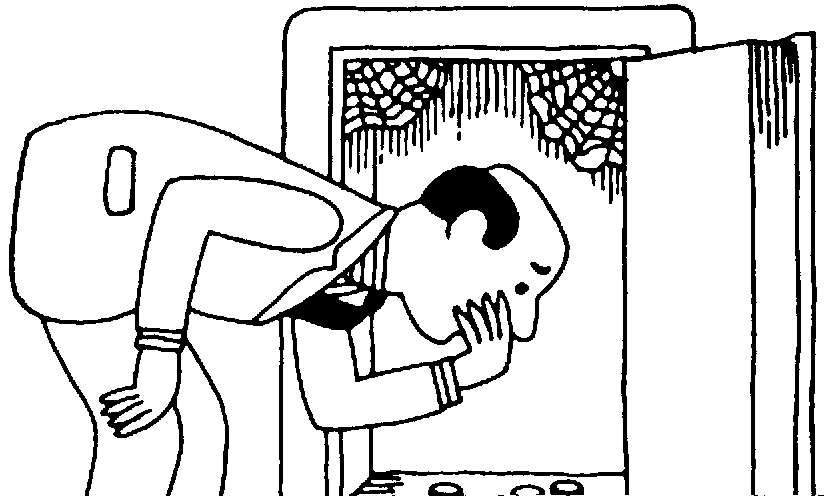The National Debt
Series for Economic Education
FEDERAL RESERVE BANK OF PHILADELPHIA
Many people view the National Debt as they would a picture in a gallery. The impression is colorful, emotional and, as often is the case with modern paintings, highly controversial.
Some see the Debt in somber hues — an oppressive burden, a mortgage on the future. They perceive overtones of runaway inflation and national bankruptcy.
A large and growing number of analysts, on the other hand, now regard the National Debt as something useful, if not an actual blessing. In the New Economics
a debt-increasing Federal deficit is often considered desirable, not only to promote recovery from a recession, but to stimulate economic growth as well.

Clashes on the Debt are nothing new. Thomas Jefferson wished it were possible to amend the Constitution … taking from the Federal Government the power of borrowing.
In contrast Alexander Hamilton wrote A national debt, if it is not excessive, will be to us a national blessing.
Today, however, the disputes seem more prevalent than ever before.
No doubt some of the current controversy results from the tendency we mentioned to view the Debt as a picture. Paintings on canvas lack dimension; you can see only one side. In the case of the Debt, people tend to see only the borrower's side.
Perhaps the nature of the Debt would be less confusing if more Americans viewed it as a statue instead of a painting. One can walk around a statue and see it from the other side.
In this pamphlet we shall walk around the National Debt and look at it from the other side — the lender's side. This vantage point may add clarity because much of the impact and effect of the Debt depends on who puts up the money and how they do it.
We are passing a burden to our grandchildren.
This is one of the most common of the many cliches that have come to be associated with the National Debt. It implies that future generations will have to give up part of their income to reduce, or at least to pay interest on, the Debt.
A simple analogy might shed some light on the burden of the Debt. Suppose there were two brothers in a family, and one wanted to borrow $100. If he got his loan from a bank he would have to make repayments by mailing a check every month. These repayments would reduce the wealth of the family and thus could be considered a burden on the family unit.
Now suppose that the one brother borrowed the $100 from the other brother. In this case, the repayments would go from brother to brother and the money would never leave the family.
The same principle applies to the National Debt. If we borrowed from foreign lenders we would have to send something of value abroad to reduce the principal and/or pay interest. But if we borrowed from domestic lenders, the payments for debt service would remain at home and the Debt could not be considered a net burden on the United States as a whole. This, in essence, is the case. Domestic lenders have put up 95 percent of the money borrowed by the Federal Government. And so we hear another equally common cliche:
The Debt really is no problem because
we owe it to ourselves.
Like many slogans and simplifications, this one is not entirely accurate. In our illustration, the brother-to-brother debt may not have been a net burden on the family as a whole, but it certainly was a burden on the future income of the debtor brother. The National Debt also can be a burden on certain groups within the United States family.
If American people and companies paid taxes in exact proportion to their Government security holdings, the Debt would be a small burden, indeed. Taxpayers would get back in interest or principal repayments an amount approximating the part of their taxes used for debt service.

It doesn’t work out exactly that way, however. The proportion of total taxes some people pay is greater than the proportion of total Federal securities they own, and vice versa. As a result, debt service operations may alter the income and outgo of certain groups within the nation.
Lower income groups pay many taxes, some of them hidden in retail prices, but generally do not own large amounts of Government securities. Because of this, it is often claimed that the existence of a huge Federal Debt is a relatively greater burden on people with modest incomes than on more well-to-do individuals and business firms.
The Debt is inflationary.
Here again the identity of the lenders is the key. If individuals and businesses lend their savings to the Government, the result is not likely to be inflationary. The spending by the Government - which caused the deficit and the need to borrow - is offset by a decrease in spending by the lenders. Having lent money to the Government, they have that much less to buy goods and services for themselves and no overall increase in spending results to put pressure on prices.
Increases in the Debt may cause inflation, however, if the lenders are commercial banks, the kind with checking accounts. When a bank buys Government securities, it creates new checkbook money. As the Government spends this new money, the total amount of spending in the economy increases because there is no offsetting reduction in private outlays.
At times when the economy already is producing just about all the goods and services it can, such an increase in spending serves to bid prices up. In slack periods when there is a buffer of idle workers and factories, increases in total spending are not likely to be inflationary.
So, whether increases in the Debt tend to be inflationary or not depends in part on:
- Whether commercial banks lend the money.
- Whether the economy is operating near full capacity.
The Debt reduces the effectiveness of the Federal Reserve.
The Federal Reserve fights inflation by limiting the ability of commercial banks to make loans and investments. The purpose is to influence spending with borrowed money and thereby help prevent total spending from getting out of line with the near-capacity production of goods and services.
With the supply of bank credit thus limited in the face of a strong general demand for loans, interest rates usually rise. Borrowers, including the Government, then must pay more for their money. As a result, the Government's interest bill - now over $21 billion a year - would be likely to increase.
In other words, higher interest payments on the National Debt are an indirect cost of fighting inflation. When you figure that galloping inflation can wipe out many billions of dollars worth of purchasing power in a short time, the cost
actually is slight. Some of us are apt to forget that keeping interest rates low in the face of inflationary pressures often results in higher prices. The increased cost of what the Government buys may be much greater than the cost of higher rates - not to mention the pernicious effects of inflation on other parts of the economy.
The Debt makes the Federal Reserve more effective.
Looking again at the other side of the statue,
the existence of many lenders holding vast amounts of Government securities makes Federal Reserve open market operations possible. Open market operations are one of the Federal Reserve's most important tools for influencing bank lending.

In effect, the Federal Reserve buys Government securities and pays out a special money the banks can use as reserves to increase their lending capacity. Conversely, when the Federal Reserve sells securities it receives this reserve money back which, in turn, reduces the banks' lending ability. Thus, Federal Reserve purchases of securities tend to increase spending with borrowed money, and sales tend to decrease it.
A huge supply of outstanding Government securities also provides a kind of leverage to help lift the economy out of serious recessions and depressions. As we said, the Federal Reserve can increase commercial banks' ability to lend in slack times but this ability may not result in much-needed additional spending if nobody wants to borrow. This is exactly what happened in the 1930s. Many potential borrowers were discouraged and did not want loans, even at very low interest rates. Huge sums of reserve money laid fallow in banks instead of working to promote recovery.
If a recession should strike today and the demand for loans should fade away again, the banks would be able to use excess reserves to buy some of the vast quantity of marketable Government securities now outstanding. These purchases would put spendable cash in the hands of the former security holders and should help stimulate recovery.
Managing the Debt has become a serious problem.
For the purpose of this discussion let's assume that all the complicated and technical questions involved in managing the National Debt can be boiled down to the decision whether to sell securities with long maturities, such as Treasury Bonds, or securities with short maturities, such as Treasury Bills.
We can make the general statement that commercial banks ordinarily are more likely to buy shorter term securities and savers more likely to buy longer term ones. The sale of Bills thus tends to increase total spending, while the sale of Bonds is more likely to tap savings. In order to reinforce the actions of other agencies, such as the Federal Reserve, which seek to smooth the business cycle, the Debt managers might try to sell more Bonds when inflation threatens and more Bills when the pendulum of business swings to recession.
The trouble is that investors' preferences often run in the opposite directions. When interest rates are rising, as they often are when prosperity increases the demand for credit, investors tend to prefer shorter maturities which enable them to reinvest soon again. At such times it may be difficult to sell Bonds at reasonable rates. On the other hand, when interest rates are on a downward trend and the economy is showing signs of recession, investors may prefer longer maturities over Bills. The Treasury must consider these preferences in order to make its securities attractive to investors.
Among the other causes of potential conflict is the fact that Bills, because of their shorter maturities, usually carry lower interest rates than Bonds. The Treasury always is under pressure to check increases in Debt service costs and its debt managers can hold down these costs by issuing Bills, even at times when they might contribute to inflation.
Debt management, therefore, is a matter of compromise and reconciling divergent objectives.
The Debt is leading us to National bankruptcy.
This time we are going to walk 360 degrees around the statue
and look at bankruptcy from both the lender's and borrower's side. Bankruptcy, in simplest terms, occurs when lenders demand repayment and the borrower can’t make it.

What are the chances that a significant proportion of the lenders of the National Debt will demand repayment? Very slight. Maturities are spaced so that only a small part of the total Debt comes due at any one time. But more important, most lenders would rather keep the securities than get their money back. Banks, trust and endowment funds, insurance companies, individuals and many others want and require safe investments. Government securities fit this description well. The taxing power of the Federal Government and, ultimately, the economic strength of the United States are behind them.
Nevertheless, let's suppose a great number of lenders (holders of Government securities) decided to demand repayment all at once. Could the borrower make it? The Federal Government, with the cooperation of the Federal Reserve, has the inherent power to create money - almost any amount of it. This power makes technical bankruptcy out of the question.
Yet this poweer also makes it possible for Governments to pursue policies that could have even more disastrous results than bankruptcy. It has happened in other countries. Governments have created too much money and accelerated inflation to runaway proportions. Soaring prices then reduced the value of interest-bearing securities to next to nothing. Many lenders and investors were severely hurt or completely ruined. This possibility, although remote, underscores the necessity of maintaining stable prices and confidence in the value of the dollar.
Is the Federal Debt too big?
This is one of those questions which should be followed by other questions such as: Compared to what?
and Compared to when?
At $475 billion, the Federal Debt has to be considered colossal. But even this figure is only 45 percent of the current Gross National Product, compared to 124 percent in 1946. On a per capita basis, the Debt stands at $2,295 compared to $1,900 in 1946. As a percentage of G.N.P., interest payments on the Debt now are 1.9 percent compared to 2.3 percent in 1946.
Looking at relative growth rates we see that the Federal Debt has increased 70 percent since World War II, while total private debt is now 10 times greater than it was at that time.
Whether one thinks it now is too large or not, the Debt seems to have grown smaller in relation to the United States economy and the Nation's ability to carry its obligations. Some people would say that this is the best way to gauge the size of the Debt.
‘The XYZ Corporation has a large debt and has no plans to pay it off …
… so why should the Federal Government?’ This rather circuitous logic is often used to justify our weakening determination to reduce the Debt. The question, however, does indicate the pervasive and permanent role debt plays in our modern economy.
Debt, or credit if you are looking from the lender's side, is necessary for economic growth. The lending-borrowing process transfers money from those who have saved it to those who wish to use it for productive purposes. This lateral pass from saver to entrepreneur takes money out of mattresses and cookie jars
and puts it to work in the form of factories, machines, schools, highways, etc. Both public and private debt perform this essential function.

The importance of the Debt to the Nation can be illustrated by examining what might happen if it were paid off or significantly reduced. Short of repudiation by decree or inflation, the Government would pay down the Debt by collecting more in taxes than it spent. Reduced Government spending, or higher taxes, or both would cause a temporary drop in total spending, pending an offsetting increase in other outlays. Purchasing power would be returned to the holders of the retired Government securities, but who knows if they would spend the money quickly enough to take up the slack in the economy? The fact that they invested the money in the first place is an indication that they had no immediate need for it.
More than likely, the lenders who receive their money back would look around for other safe, profitable investments. They would find that thousands of others were doing the same thing. Since the supply of Government securities would be drastically reduced, suitable investments would be harder to find. With borrowers in the driver's seat, interest rates on still-available investments would fall sharply. This would adversely affect the many individuals and financial institutions which are dependent on interest for all, or part, of their income.
Many modern economists believe arguments such as these mean that the National Debt need not be reduced at all. In any event, the Debt has become such an integral part of our economy that repayment should be gradual in order to provide enough time to make the required adjustments.
Conclusion
Debt has a deceptive, something-for-nothing kind of charm. William Makepeace Thackeray understood it when he wrote Everybody in Vanity Fair must have remarked how well those live who are comfortably and thoroughly in debt; how they deny themselves nothing; how jolly and easy they are in their minds.
One of the real dangers of the National Debt is that we will come to regard it with a jolly and easy
attitude and thereby lose our respect for sound financial principles. There is no magic in deficit financing.
But spending tomorrow's income for today’s goods and services is a legitimate and valuable practice. Effective use of debt, and its other side, credit, have done much to bring about America's present standard of living.
Debt can be our servant if it is employed constructively and with prudence. Used recklessly, it has the power to make us its slave.
S.E.E. is designed for easy understanding and wide distribution. Additional pamphlets will appear at irregular intervals. Multiple copies of this booklet and the others listed below are available free for distribution by organizations such as businesses, schools, unions, trade associations and banks. The titles to date are:
- Economic Man vs. Social Man
- The Price System
- The Mystery of Economic Growth
- Automation
- The New Poverty
- The National Debt
- Inflation and/or Unemployment
- Truth in Lending
- Gold
- The Growth of Government
To order copies write to the
Federal Reserve Bank of PhiladelphiaPublic Services Department
Philadelphia, Pennsylvania 19105
The rich rules over the poor,
Bible, Proverbs 22:7 — NAS
And the borrower [is] the lender’s slave.
You shall not charge interest to your countrymen: interest on money, food, [or] anything that may be loaned at interest. You may charge interest to a foreigner, but to your countrymen you shall not charge interest.
Bible, Deuteronomy 23:19-20 — NAS